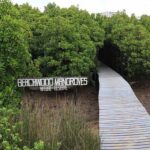The Kwa Muhle Museum situated on 130 Bram Fischer Rd in Durban is a important historical museum focusing on the struggles and adversity that Black and Indian people faced living and working in Durban, during the Apartheid Years.
The building housing the exibits was designed to accommodate the movement of large numbers of people, and use has been made of the wide open spaces for the exhibitions and educational activities.
There are 3 main exhibition halls each focusing on a different aspects of the struggle. The first hall shows black and white print style plaques explaining the different laws and acts that were enforced by the Apartheid government to keep the Black and Indian population under control. The room also hosts a display diorama of a food hall in a prison setting as well as a cell replica room. The second hall focuses in mostly on the Andrew Zondo case, a young man who let off a bomb in Pinetown’s Sanlam center back in the 80s in an act of protest, killing some people . He was sentenced to death for his actions. The third hall focuses on the various opposition groups and protests that took place against the Apartheid governmental system. Individuals like Steve Biko and Harriet Balton are highlighted as well as various trade union actions and even mass protests are noted.
The Kwa Muhle Museum was originally the offices of the native administration Department, a central cog in the machinery of apartheid and the center of Durban’s harsh system of labour control. It is a fitting irony that the museum now displays reconstructions of the oppressive environments experienced by the black population of South Africa under apartheid, offering a window into the harsh realities of the period.
“Kwa muhle” is a Zulu term that means “the place of the good one” and was named in reference to its first manager, Mr Marwick. This man helped no fewer than 7 000 Zulu people to escape Gauteng (then called the Transvaal) during the Anglo-Boer War. He was thus instrumental in saving the lives of thousands of native South Africans in a time when their blood was sought by settlers and farmers.
It is 1 of only 4 major local history museums in Durban. The other museums under this umbrella are the Old House Museum, Old Court House Museum and the Port Natal Maritime Museum. Visiting each of these institutions will certainly give visitors a well rounded idea of past and present South Africa, and will impart important lessons on how to go about shaping the future.
This Museum has free entrance and opens Monday to Friday from 08.30 to 16.00 and on Saturdays from 08.30 to 12.30. Closed on Sundays.
The Durban Art Gallery and the eThekwini City Hall are both situated close to the museum, and are a fabulous addition to your cultural and historical experience of this bustling, modern city. In addition, city tours are available, giving visitors the opportunity to learn more about the coastal city and its national and international identity.




